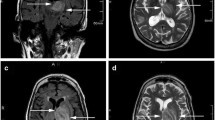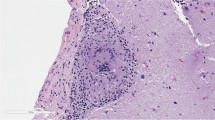Summary
Clinical and brain biopsy or autopsy findings in six patients with Granulomatous Amebic Encephalitis (GAE) due toAcanthamoeba sp. were characterized by focal neurological symptoms, increased intracranial pressure, and focal neuroradiological findings. Craniotomies were performed because of the diagnostic possibility of a mass lesion such as a brain tumor or abscess. In four patients, frozen sections demonstrated free-living amebas. GAE may present as an acute or subacute intracerebral mass lesion with signs and symptoms of focal brain disease and should be differentiated from viral, bacterial, fungal, and other protozoal encephalitides.
Similar content being viewed by others
References
Bell W, Butler E (1968) Cerebral mycotic aneurysms in children. Two case reports. Neurology (Minneap) 18:81–86
Bhagwandeen SB, Carter RR, Naik KG, Levitt D (1975) A case of Hartmanellid amebic meningoencephalitis in Zambia. Am J Clin Pathol 63:483–492
Borochovitz D, Martínez AJ, Patterson TG (1980) Osteomyelitis of bone graft of mandible withAcanthamoeba castellanii infection. Hum Pathol (in press)
Callicott JH, Nelson EC, Jones MM, dos Santos JG, Utz JP, Duma RJ, Morrison JV (1968) Meningoencephalitis due to pathogenic free-living amoebae. JAMA 206:579–582
Casemore DP (1970) Sensitivity ofHartmannella (Acanthamoeba) to 5-fluoro cytosine, hydroxystilbamidine and other substances. J Clin Pathol 23:649–652
Červa L, Serbus C, Skočil V (1973) Isolation ofLimax amoeba from the nasal mucosa of man. Folia Parasitol (Praha) 20:97–103
Culbertson CG, Smith J, Cohen H, Minner J (1959) Experimental infection in mice and monkeys byAcanthamoeba. Am J Pathol 35:185–197
Culbertson CG (1961) PathogenicAcanthamoeba (Hartmannella). Am J Clin Pathol 35:195–202
Culbertson CG (1971) The pathogenicity of soil amebas. Ann Rev Microbiol 25:231–254
Duma RJ, Helwig WB, Martínez AJ (1978) Meningoencephalitis and brain abscess due to free-living amoeba. Ann Intern Med 88:468–473
Dyner E (1974) Les immunosuppresseurs et les amibes de l'eau. Ann Soc Belg Med Trop 54:405–408
Gullett J, Mills J, Hadley K, Podemski B, Pitts L, Gelber R (1979) Disseminated granulomatousAcanthamoeba infection presenting as an unusual skin lesion. Am J Med 67:891–896
Heidelberger KP, Layton WM, Fisher RG (1968) Multiple cerebral mycotic aneurysm complicating post-traumaticPseudomonas meningitis. J Neurosurg 29:631–635
Hoffmann EO, García C, Lunseth J, McGary P, Coover J (1978) A case of primary amebic meningoencephalitis. Light and electron microscopy and immunohistologic studies. Am J Trop Med Hyg 27:29–38
Jager BV, Stamm WP (1972) Brain abscesses caused by free-living amoeba probably of the genusHartmannella in a patient with Hodgkin's Disease. Lancet II:1343–1345
Jones DB, Visvesvara GS, Robinson M(1975)Acanthamoeba polyphaga keratitis andAcanthamoeba uveitis associated with fatal meningoencephalitis. Trans Ophthalmol Soc UK 95:221–232
Kenney M (1971) The micro-kolmer complement fixation test in routine screening for soil ameba infection. Health Lab Sci 8:5–10
Kernohan JW, Magath TB, Schloss GT (1960) Granuloma of brain probably due toEndolimax williamsi (Iodamoeba bütschlii). Arch Pathol 70:576–580
Kingston D, Warhurst DC (1969) Isolation of ameba from the air. J Med Microbiol 2:27–36
Lawande RV, Abraham SN, John I, Egler LJ (1979) Recovery of soil amebas from nasal passages of children during the dusty Harmattan Period in Zaria. Am J Clin Pathol 71:201–203
Lengy J, Jakovlzevich R, Tolis B (1971) Recovery of a Hartmannelloid ameba from a purulent ear discharge. Trop Dis Bull 68:818
Lund O, Stefani FH, Dechant W (1978) Amoebic keratitis. A clinicopathological case report. Br J Ophthalmol 62:373–375
Markowitz SM, Sobieski T, Martínez AJ, Duma RJ (1978) ExperimentalAcanthamoeba infections in mice pretreated with methylprednisolone or tetracycline. Am J Pathol 92:733–741
Martínez AJ, Sotelo-Avila C, Alcalá H, Willaert E (1980) Granulomatous encephalitis, intracranial arteritis and mycotic aneurysm due to a free-living ameba. Acta Neuropathol (Berl) 49:7–12
Martínez AJ, Sotelo-Avila G, García-Tamayo J, Takano-Morón J, Willaert E, Stamm WP (1977) Meningoencephalitis due toAcanthamoeba sp.: Pathogenesis and clinicopathological study. Acta Neuropathol (Berl) 37:183–191
Martínez AJ, Markowitz SM, Duma RJ (1975) Experimental pneumonitis and encephalitis caused byAcanthamoeba in mice: Pathogenesis and ultrastructural features. J Infect Dis 1313:692–699
Martínez AJ, dos Santos JG, Nelson EC, Stamm WP, Willaert E (1977) Primary amebic meningoencephalitis. In: Sommers SC, Rosen PP (eds) Pathology annual, vol 12, part 2. Appleton-Century-Crofts, New York, pp 225–255
Martínez AJ (1980) IsAcanthamoeba encephalitis an opportunistic infection? Neurology (Minneap) 30:567–574
Moore AE, Hlinka J (1968)Hartmannella sp. (Acanthamoeba) as a tissue culture contaminant. J Natl Cancer Inst 40:569–581
Nagington J, Watson PG, Playfair TJ, McGill J, Jones BR, McG Steele AD (1974) Amoebic infection of the eye. Lancet II:1537–1540
Ringsted J, Jager BV, Suk D, Visvesvara GS (1976) ProbableAcanthamoeba meningoencephalitis in a Korean child. Am J Clin Pathol 66:723–730
Robert VB, Rorke LB (1973) Primary amebic encephalitis probably fromAcanthamoeba. Ann Intern Med 79:174–179
Skočil V, Červa L, Serbus C (1970) Epidemiological study of amoebas of theLimax group in military communities. First report. J Hyg Epidemiol Microbiol Immunol (Praha) 14:61–66
Sotelo-Avila C, Taylor EM, Ewing CW (1974) Primary amebic meningoencephalitis in a healthy 7-year-old boy. J Pediatr 85:131–136
Takano-Morón J, Cabrera J, Franco F, Martinot C (1976) Meningoencephalitis Amibiana primaria subaguda. Patologia (Mexico City) 14:287–297
Wang SS, Feldman HA (1961) Occurrence ofAcanthamoeba in tissue cultures inoculated with human pharyngeal swab. Antimicrobiol Agents Chemother 1:50–53
Wang SS, Feldman HA (1967) Isolation ofHartmannella species from human throats. N Engl J Med 277:1174–1179
Willaert E, Stevens AR, Healy GR (1978) Retrospective identification ofAcanthamoeba culbertsoni in a case of amoebic meningoencephalitis. J Clin Pathol 31:717–720
Author information
Authors and Affiliations
Rights and permissions
About this article
Cite this article
Martínez, A.J., García, C.A., Halks-Miller, M. et al. Granulomatous Amebic Encephalitis presenting as a cerebral mass lesion. Acta Neuropathol 51, 85–91 (1980). https://doi.org/10.1007/BF00690448
Received:
Accepted:
Issue Date:
DOI: https://doi.org/10.1007/BF00690448




